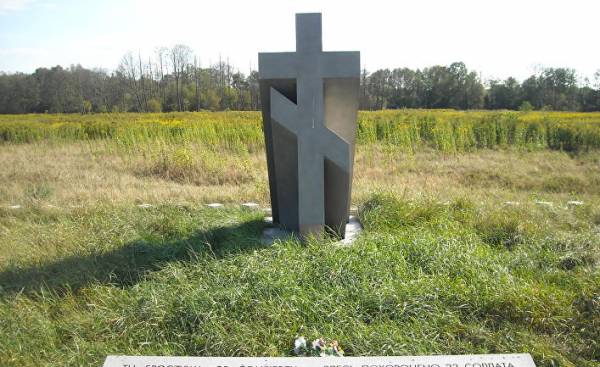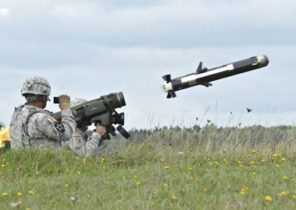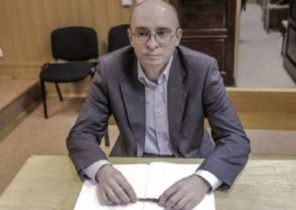
As reported by Gazeta Wyborcza, consisting of the party “law and Justice” (PiS), the former mayor of the city of Wołomin and the head of the regional Department of the trade Union movement “Solidarity” we want the Institute of national remembrance eliminated in the village of Ossow the grave of red army soldiers appeared in 1920. In their letter they say it is “may become a source of conflict and to create a pretext for provocations.” They ask “to transfer the remains of soldiers of the Bolshevik army, resting in the fields near Ossowa, and to dismantle the monument, which was erected in honor of the invaders gathered on bayonets, over the corpse of Poland, to bring a revolution in the heart of Europe. (…). Ossv is an important place for the poles, and there I praise the Bolsheviks.”
For many years the grave no one was interested
These soldiers did not smile soldier’s luck: after the battle they were buried not in the cemetery, and buried in a common grave. Who were they, what were their names, how old were they unknown. Their remains are quietly lying in the ground, and their fate no one in particular — or, more precisely, in General — not interested.
On the tomb was known from oral narratives, it was not even the exact information, how many people are buried there. However, in 2008 during the creation of the landscape Park, dedicated to the Warsaw battle, archaeologists excavated the mound and found the grave of the remains of 22 people. Some, in all probability, belonged to the lost English observer: it was pointed out to found an English military jacket. Continue around the grave there were some scandals and problems: installation of the obelisk was planned for 2010, and the ceremony was supposed to take under the patronage of the speaker of the Sejm Bronislaw Komorowski (Bronisław Komorowski). The initiator of the event was the Council of protection of memory of struggle and martyrdom.
It could go anyway and do without scandals, if not near Smolensk the plane crashed, which killed, in particular, the General Secretary of the Council Przewoznik Andrzej (Andrzej Przewoźnik). Things have changed, but the theme of the graves in Assume (or, more precisely, in the vicinity of Assuwa) began to inflame passions and awaken demons. It was the first time heard word about the invaders, who were going “over the corpse of Poland to bring to Europe the revolution.” Now we see only a repetition of phrases from old letters.
Why can’t we leave the grave alone?
All of this is true: the Bolsheviks invaded Poland and sown on the road of death, without looking to any contracts. So. But we won. Really, after almost one hundred years we are not able to leave resting under Osobom soldiers alone? We don’t even know who they were convinced by the Bolsheviks, or men who enlisted in the army, as many of the descendants of poles who lived in pre-revolutionary Russia. Are we not able to show the generosity of the winners? They died almost a century ago, and we behave so petty and argue over their grave. What it gives us? It is due to this we feel baboutgreat patriots? In our history, including that period, you can find a lot of beautiful moments that allow you to experience the feeling of joy and pride. Is this form of revenge (what else can it be called) brings someone satisfaction? Should a political war to take such a form? We should calmly think over these questions and find them honest answers in your heart.
I would like to cite here a quote from the article of Professor Anthony Dudek (Antoni Dudek), who appeared on the pages of the newspaper Rzeczypospolita in the same 2010, when war broke out the grave in Assume. I fully share this position and believe that this approach should be called manifestation of patriotism.
“Since the end of the Polish-Bolshevik war’s been over for 90 years. It’s long enough to look at the events of those years calmly, without excessive emotion. So the idea of combining the celebration of the great victory won by the soldiers of the revived Polish state on 15 August 1920 the Bolsheviks, with the opening of the monument dedicated to the victims of the opposite side, it seems to me absolutely correct.
I am convinced that we are able to make such a gesture not only to honor the memory of our heroes who defended Polish independence, but also to remember the tragic fate of the soldiers of the army of the invaders. We should not forget that many were in its ranks not on their own. We respect the graves of foreign soldiers who are buried in the Polish land, so I see no reason to resent the idea to supply them with a symbolic obelisk.
I don’t agree with the statement that in this way we erect a monument to the red army, which sought to conquer Poland and all of Europe. Of course, we should not erect monuments to the criminal regimes like communism and Nazism, but I don’t see anything wrong with that, to honor the memory of a soldier killed in the war. (…) Returning to the theme of the obelisk in Assume. This monument is symbolic that it has the shape of a cross. Hard to call it a symbol of the red army or Bolsheviks, who called one of its main goals the fight against the Church and religion. The majority of soldiers who fought in the ranks of the red army in those years, were believers. And this is perhaps most eloquently suggests that this monument, we not glorify the criminal regime or the invading army, and pay tribute to the memory of specific soldiers who fell under Assuwa”.







